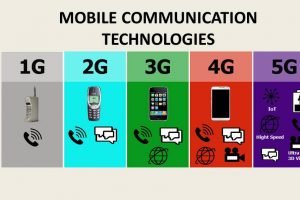
Emerging Technologies: Notes
- Categories Emerging Tech
Notes on Emerging Technologies including Internet of Things, Cloud Computing, Artificial Intelligence and 5G.
Answer the following questions.
- What is IoT (Internet of Things)?
Ans.
The internet of things (IoT) is the network of physical devices, vehicles, home appliances, and other items embedded with electronics, software, sensors, actuators, and connectivity.
- What are the advantages of IOT?
Ans.
- Efficient resource utilization: With better knowledge of device functionality and of the way how each device works, we can increase the efficient resource utilization as well as monitor natural resources.
- Minimize human effort: IoT devices can interact and communicate with each other and do lot of task for us, so they minimize the human effort.
- Time saving: As IoT devices reduce the human effort, it definitely saves our time.
- Enhance data collection: IoT devices can collect data from environment like weather, sound, pollution etc.
- Improve security: IoT based security systems can make home or office environment secure.
- What are the disadvantages of IoT?
Ans.
- Privacy: Even without the active participation of the user, the IoT system provides substantial personal data in maximum detail.
- Complexity: The designing, developing, maintaining and enabling the large technology to IoT system is quite complicated.
- What are the applications of Iot?
Ans.
- Smart lighting: Illumination of light is controlled on the basis of day light.
- Smart thermostats: Allows users to schedule, monitor and remotely control home temperatures.
- Smart locks and garage – door openers: Password based or facial recognition based doors and locks.
- Smart security cameras: Security cameras that can identify known and unknown person and raise alarm, in case of security threat.
- Smart traffic signals: Signals that can adjust their timing to accommodate commutes and holiday traffic and keep cars moving.
- What are the Features of IaaS?
Ans.
- Users pay for IaaS on demand. No need to buy expensive hardware.
- Infrastructure is scalable depending on processing and storage needs.
- Enterprises save the costs of buying and maintaining their own hardware.
- Write features of PaaS Cloud Computing Service.
Ans.
- PaaS provides a platform with tools to test, develop and host applications in the same environment.
- Enables organizations to focus on development without having to worry about underlying infrastructure.
- Providers manage security, operating systems, server software and backups.
- Facilitates collaborative work even if teams work remotely.
- What are the features SaaS Cloud computing?
Ans.
- SaaS vendors provide users with software and applications via a subscription model.
- Users do not have to manage, install or upgrade software.
- Data is secure in the cloud; equipment failure does not result in loss of data.
- Use of resources can be scaled depending on service needs.
- Applications are accessible from almost any internet-connected device, from virtually anywhere in the world.
- What are the different types of cloud computing?
Ans.
There are three basic types of cloud computing: Public, Private and Hybrid.
- What are the Benefits of Cloud Computing?
Ans.
- Cost saving: cloud computing solutions are inexpensive than the actual overall infrastructure set up for the I.T services.
- Reliable: Cloud computing solutions are more reliable than in-house I.T infrastructure.
- Mobility: Cloud computing solutions are more portable because user can access data anytime, anywhere as required.
- What is Artificial intelligence?
Ans.
Artificial intelligence (AI) is an area of computer science that emphasizes on the creation of intelligent machines that work and react like humans.
- What are the advantages and disadvantages of artificial intelligence?
Ans.
Advantages of artificial intelligence:
- Reduction in human error: Properly programmed AI computers can give 100% accuracy as compared to tasks performed by humans as there is always a chance for human mistakes.
- Digital assistance: Some of the highly advanced organizations use digital assistants to interact with users. This saves the need for human resources.
- Faster decisions: Using AI alongside other technologies, we can make machines take decisions faster than a human and carry out actions quicker.
- Daily applications: Daily applications such as Apple’s siri, Window’s cortana, Google’s ok google are frequently used in our daily routine whether it is for searching a location, taking a selfie, making a phone call, replying to a mail and many more.
Disadvantages of artificial intelligence:
- High Costs of creation: As the machines used in AI based environments are very complex and high in price, it increases the cost for overall set up.
- Unemployment: As AI is replacing the majority of the repetitive tasks and other works with robots. This will reduce human interference but cause a major problem in the employment standards.
- What are digital cellular networks?
Ans.
A digital cellular network is a network in which the service area covered by providers is divided into small geographical areas called cells.
- List the features of 5g network.
Ans.
- High speed data transfer
- ultra HD Videos
- Reduced Website load time
- Reduced App load time
- Multiple times faster than 4G
- IOT based applications
- Write applications of 5G.
Ans.
- Online 5G games.
- Automated vehicles.
- Virtual classrooms.
You may also like

Emerging Technologies – Question and Answers
11 January, 2021

Mobile Telecommunication Technologies
27 November, 2020
